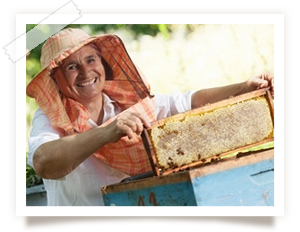Beekeeping

Sweet responsibility for food, farming and nature protection
A tasty slice of bread, thickly spread with honey, is an everyday thing nowadays. The fact that this is possible and affordable is all due to the beekeepers.
With a steady, experienced hand they maintain the bee colonies and support their development. They help to bring the bees safely through the harsh winter. Modern beekeeping has now enabled large quantities of top-quality honey to be harvested.
Yet beekeepers and their bees not only have responsibility for the sweet enjoyment of honey but are also of decisive importance for agriculture. Farmers can reap a good harvest only if there are enough bees to pollinate the crops.
Of course bees also take care of the necessary pollination of wild plants. In this way beekeepers make an important contribution to nature protection.
To produce honey bees first collect their raw material, sucking up nectar from the flowers or honeydew from leaves or tree needles with their long probosces, or mouth parts. This is mixed with saliva and saved in the honey sac.
In the beehive the bees of the colony store their still very wet nectar in the honeycombs. They repeatedly take it into their honey sac and release it again. Meanwhile their wings ensure a constant flow of air.
In this way they extract water from the nectar. The increased temperature in the beehive - which amounts to 30°C to 35°C - also contributes to the process.
The enzyme-containing saliva secretion of the bees converts the oligosaccharides (multiple sugars) of the nectar into monosaccharides (simple sugars), which are fructose and dextrose. Thus the nectar is gradually transformed into honey. When it's ready, the bees close the full honeycombs with a wax lid. For the beekeeper it's the sign that the honey is "ripe".
To harvest the honey, the beekeeper first removes the honeycomb frames. Then he takes off the wax capping. Next the honeycomb piece is clamped to a centrifuge, and the rotating action flings the honey out the honeycombs. A fine sieve now filters out the honeycomb remains, little pieces of plants and foreign bodies. Finally the honey can be bottled.
Apart from the harvesting, the beekeeper has many other tasks to do during the year. He must continually monitor his bee colonies. This is the only way to know what condition they're in and whether it's time to split a hive. The development of a colony is in the beekeeper's hands, and he must use foresight. However the proper breeding of bees is usually reserved for large apiaries or special bee breeders.
The beekeeper also keeps his eye on the weather and the flowers surrounding his hives. Like this he knows, for example, which varieties of nectar and pollen his bees are currently collecting. In autumn the bees receive winter feed so that they can store up their supplies in preparation for the cold season. Moreover he repairs the beehives and prepares them for winter.
Already thousands of years ago special dwellings were prepared for bees so that people could collect their honey more easily. At first they closed up hollowed-out tree trunks on two sides with boards.
The first "beehives" were born. Such classical log hives were used until modern times and were sometimes richly decorated with carvings. In ancient Egypt bees were sometimes kept in clay tubes. Here there were also bee baskets. Since then, baskets made of straw, cane or rushes have served as beehives in many parts of the world. In all these bee dwellings honeycombs are firmly inserted. Therefore in order to obtain the honey a part of the hive must always suffer damage.
Moveable honeycomb frames were invented In the mid-19th century. These can be easily removed, freed of the honey and finally reattached.
